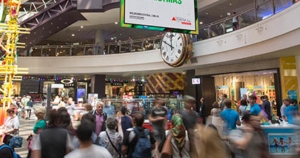A chain is only as strong as its weakest link, right? Well, the same sentiment can be applied to an LED display. Though the diodes within an LED display can seem identical to the naked eye, every diode is not made equal, and one bad diode can compromise an entire display. Each diode made in a given production run will exhibit tiny variances from the others in its batch, despite the fact that they were all created with the same materials. For this reason, manufacturers sort newly created diodes through a classification process that groups together like diodes.
How Does Binning Work?
This diode sorting process is referred to within the industry as “binning,” and generally, the two criteria manufacturers use to bin their diodes are color wavelength and forward voltage. These two metrics measure the specific color profile and brightness levels of a given diode, and as you can imagine, the narrower the parameters are for each group, the more similar each diode’s performance level will be to that of the diodes it’s grouped with. Displays built with like diodes from the same bin will exhibit a more cohesive picture, whereas displays built with varied diodes from diverse bins can appear splotchy and interrupted. For example, imagine your display is showing an image of a man in a dark black suit. On a properly binned display, that entire suit will be the same dark black, but on a display built with blended pixels, the suit might appear different shades of black in different areas of the picture.
Due to the outsized impact diode consistency can have on a display, the precision with which binning is performed is one of the primary differentiators between top-end manufacturers and their lower-quality competition. The companies that use the best, most consistent materials are the ones that produce the best finished products, just as, for example, a chain manufacturer that uses ideal, highly similar links will create a better end product than a manufacturer using a divergent blend of links ranging in quality.
Here at Nanolumens, we pride ourselves on purchasing only the diodes from within the highest quality bin. For example, if the ideal color wavelength for a red diode is roughly 625 nanometers, Nanolumens will only use the red diodes measuring within 3 nanometers of that figure. The diodes within our acceptable range account for only around 5% of the total production run, so purchasing such specific sets does add cost. The increased expense of this precision proves justifiable however when comparing Nanolumens’ display quality to that of less meticulous manufacturers.
Calibration
Lower-end LED manufacturers buy their diodes from across the entire remaining production run and then blend these varied diodes together when building their display. Red diodes measuring a wavelength of 600 nanometers get mixed up with diodes measuring at 650 nanometers, leading to a display that exhibits splotchy image quality. To remedy these inconsistencies, manufacturers perform a smoothing process called calibration. Sophisticated optical equipment gathers data on every pixel within a display, and then runs that data through analyzing software to generate a coefficient to apply to each diode. Once applied, these coefficients attune the performance of every diode in the display down to the levels of the worst-performing diode. This process improves the consistency of the display, but it reduces the brightness, resulting in a proportional decline in grayscale quality. As grayscale quality erodes, the slight differences between shades of the same color begin to fade. In other words, on a calibrated display, Coca-Cola red may no longer be distinct from other reds.
Recall from earlier the example of the man in the dark black suit. Now imagine that man is standing next to someone wearing a gray suit. In a calibrated display that has lost grayscale uniformity, these two suits might appear to be the same color. That’s a problem. A display built with diodes that have been expertly binned will always show the difference between black and gray suits, but a display requiring calibration might not. The absence of strict binning policies from a manufacturer could leave you overpaying for something that will underperform as soon as it arrives on site. That’s an even bigger problem. Calibration itself is a good thing because it smooths overall consistency, but ideally a display shouldn’t require it to be conducted in the first place. Fortunately, the displays we produce here at Nanolumens use diodes from such a narrow range that there is no need to calibrate their performance after assembly; they are already perfectly attuned.
Conclusion
As pixel pitch shrinks in the years to come, the importance of specialized binning will grow. Differences between diodes and the reduced performance of calibrated displays will be noticeable for audiences viewing displays from shorter distances, so it is crucial to understand the binning policies of each LED manufacturer; their process matters a lot more than you might have previously thought. Nanolumens displays use only like diodes from the best-performing bin, and thus our displays perform at a much higher level than displays using varied diodes that need to be calibrated. After all, a chain is only as strong as its weakest link, and an LED display is only as good as its lousiest diode.
To learn more about why binning is so important, check out some more information on gray scale uniformity here.
~Almir DeCarvalho
Vice President of Sales, East Coast

